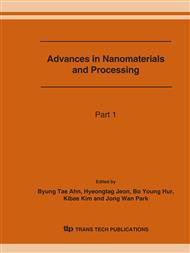p.21
p.25
p.29
p.33
p.37
p.41
p.45
p.49
p.53
Thermal Stress Model for Phase Change Random Access Memory
Abstract:
Thermal stress model considering the effect of phase transformation is proposed for Phase-Change Random Access Memory (PRAM). The results of simulation show that the high level of stress is generated on the junction where Ge2Sb2Te5(GST), TiN and SiO2 meet together. The high level of stress can also be observed in the interface between TiN and SiO2. From simulation results, it can be predictable that delamination between GST and TiN can occur during operation of PRAM. It is expected that the simulation model, which has been developed in this research, is very useful tool for PRAM device design.
Info:
Periodical:
Pages:
37-40
Citation:
Online since:
June 2007
Keywords:
Price:
Сopyright:
© 2007 Trans Tech Publications Ltd. All Rights Reserved
Share:
Citation:


